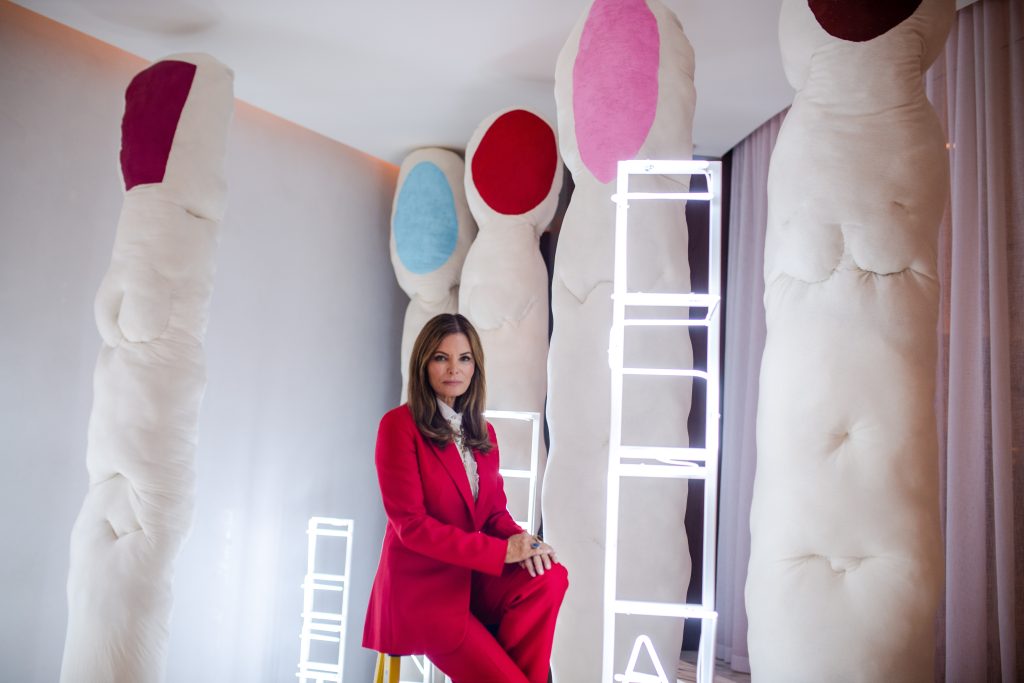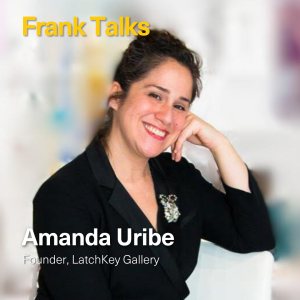Suzy Kellems Dominik is a multi-disciplinary artist and emotional autobiographer whose body of work is underscored by a profound empathy for the vulnerability of the human condition. Her practice is characterized by diligent research into cultural ritual and societal taboos. She often places herself at the heart of the work to expose rigidly antiquated social constructs and reveal the essence of the human desire to connect, communicate, and commune.
Drawing on the endlessly expressive qualities of film, performance, photography, and sculpture, Kellems Dominik explores objectification and the male gaze, human trauma, female sexuality, agency, and her own experience of loss and survival.
Her work has been featured internationally in exhibitions including Onishi Project in New York, Coup d’Etat in San Francisco, the PUBLIC Hotel in Chicago, the Nautilus Hotel in Miami, and Soho House New York, among others.
What was your first job in the Arts?
My first true job in the art world is as an artist. I dedicated myself to art later in life, when I turned 50. I have been a life-long learner, I have collected experiences and skills across dance and the arts, but I never formally trained as an artist. I applied tenacity and will and have assumed the role of a self-teaching artist since.
What was the most useful or important thing you learned at that job?
I think for me it has always been to maintain a sense of humor. Life, art and beyond, will humble you. You need to be well suited to have the stuffing kicked out of you to then be able to inject that into your work; to put yourself out there.
My art is highly personal. I consider my medium to be an emotional autobiography because it is about my life, about my lived experience.
But there is a universality that has emerged from exhibiting my work that has perhaps been the most important lesson I’ve learned. Despite the range of vastly different life experiences, people are universal. There exists a magical spot at the core that is open for all to relate to. Human emotion can be genderless, ageless.
Tell us a little more about yourself. When did you realize you wanted to pursue a career in this industry?
I spent my life gaining vast and profound life experience, but not formally in the capacity of artist.
I took copious notes — the intellectual facet of my life — for more than a decade before I sat my family down on my 50th birthday to say that I felt the need to direct my attention in this way. I needed to share this excavation of emotion through art. It was time to be a maker, not just a thinker. I’ve never been afraid to fail so I just did it.
What do you do now?
I am an artist. An emotional autobiographer. I create work that is agnostic of medium. I choose media reactively, as a tool. I collaborate, I learn, I experiment, and I seek to communicate my story. I am a self-teaching artist.
Where are you from?
California.
What is the arts community like there?
I have always been outward looking. I’ve never considered myself tethered to geography. My understanding of an arts community was always more global than my immediate surroundings.
Has where you come from shaped what you do in the arts today?
My geography has not shaped me. My experience has. My global curiosity led me beyond my hometown. I sought global experiences. That of history, ruins, architecture and archaeology, fashion and literature.
The exception is perhaps now, I feel tethered to my studio and home in Jackson Hole, Wyoming. My most recent bodies of work are literally rooted in the landscape there. They take place in the land. I get to experiment with the chemistry of where the human meets the natural. The inflection point between daylight and dusk, etc.
What is the best piece of advice you can give about working in the art world?
Do not allow anyone to dictate your creativity or direction. Assume total freedom. This may put you outside the prescribed box. You may need to claw your way, but this is where meaning is made. Reject a rote career trajectory or the dogmas of the traditional career path.
What is one of your greatest accomplishments in your career so far?
Every little step, every little victory, even the failures. These are all accomplishments.
A tangible moment was when I was invited to donate a work — a small neon sculpture — to the Watermill Center’s summer benefit. A couple mentioned to me that they had seen my neon sculpture, I Can Feel, previously and had wanted to experience more of my work in person. It was the first time I acknowledged that my work lived independently of me. That people had been exposed to my practice and were having a sort of intellectual critique of my practice beyond my immediate grasp.
What has been a challenge for you?
I’m challenged everyday by the fact that I do not fit the traditional art world model. I do not hold an MFA, I have not experienced those mentor/mentee relationships in a formal way, and while my creative resources abound, I have never belonged to a specific artistic community.
It is a dual edge sword. Freedom is a gift, but I confront frustration when my CV becomes a hindrance in more traditional art world application processes, such as for residencies or juried exhibitions.
What is something you do every day at the office (or your current home office)?
I scour, create, and capture research material. Images, articles, film clips. I am immersed in constant R&D. Google deep-dives are a launchpad for me. I took notes my entire life! Imagine, I have over 51,000 photos on my current iPhone alone. My phone is my greatest research tool and repository.
What is one of the weirdest things you have had to do on the job in your career?
Surely ordering pig heart and quarts of blood from a butcher shop for a photographic series I shot. I have a good relationship with the local butcher…ha! Not a typical artist task.
What defines a good employee? What defines a good boss?
Reciprocal mentorship relationships. Surround yourself with collaborators that teach you but also are open to being taught. A strong team member strives to learn every day, and a good boss strives to do the same!
What started as a core series of strong women has grown into an extended studio of individuals who wield ambitious skills. Take drone piloting for instance. I am much like a director and producer. Strong communication and mutual understanding makes it all come together.
What do you think makes a person hirable?
When it comes to creativity and imagination, “no” is not an answer. We may troubleshoot a concept and recognize that in the end, it is neither practicable nor feasible, but that cannot be the dead end. It is a jumping-off point. A strong team is adaptable. They creatively problem solve. They give it a go.
Otherwise, honesty, loyalty, intellectual curiosity, the courage to be open…and organization! The artist’s fatal flaw, ha!
What is your advice to making yourself stand out in your workplace? Any good tips for a giving a great interview?
Anything worth doing takes hard work. Emotional and physical labor. No one will do it for you. Earn your luck. Know your worth.
For an interview, do your research, know your audience, think in advance of questions you’d ask yourself. Make sure you walk out having hit your three top takeaways.
Is there any advice you would like to give people entering the art world?
Stay intellectually current by exposing yourself to exhibitions and projects presently on view, but do not allow this to stifle your imagination. Give others the permission to critique you, but not to break you.
What artwork is in your home office?
Beyond my own work, among my favorites are works by Stephen Powers (ESPO), Hirosuke Yabe, Louise Nevelson, as well as ancient artifacts. I surround myself with the contemporary and the historic.




